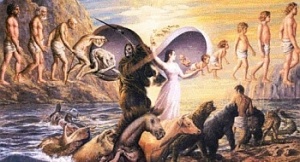.jpg) |
| Credit: monicaglovine.co.uk |
( CONTINUED FROM PREVIOUS POST )
The 'shroud' or physical body has certain attributes which we call personality. There are numerous shrouds with varying textures (people with a range of personalities) covering the souls which are themselves beyond personality, being divine, pure and eternal. The physical personality ,which the entrapped soul does not share, is also called Ego. Unlike the soul's purpose, which we shall discuss later, the Ego or physical personality's purpose is defined by self-preservation - the survival, success and well-being of the physical entity by overcoming any obstacles that come in its path. This compulsion to survive produces the qualities of that personality - selfishness, desire to procreate and thereby perpetuate oneself, jealousy arising from comparisons and competition, aggression to enable acquisition of something valuable that another may possess, dominance to subdue others, sorrow pleasure etc. The shroud is made up of these materialistic qualities.
Some shrouds are thick, coarse and rough. Others are of fine texture and some are so refined as to be transparent. The soul is not visible through some shrouds that are thick like blankets. But as the shrouds improve and evolve its light begins to show through and finally when the shroud becomes transparent, the soul shines forth. The personalities of people like Gandhi or the Buddha would have been such refined shrouds and the soul would then shine brightly through their eyes, their actions and their deeds.
The material shroud that covers the soul or the human body that embodies it, basically are quite independent of the soul, neither being governed, dominated or directed by it. The body or person is in fact governed, directed and dominated only by the personality-ego - mind complex, which is entirely physical. The ego goes about urging the physical person to do its bidding in enhancing pride and prestige, acquiring wealth,satisfying desire, rising above others, imposing ones will, exercising power, dominating others, preserving, protecting and enhancing its level of existence by obsessively grasping every opportunity. What role the soul plays we shall see later.
(MORE IN THE NEXT POST)



